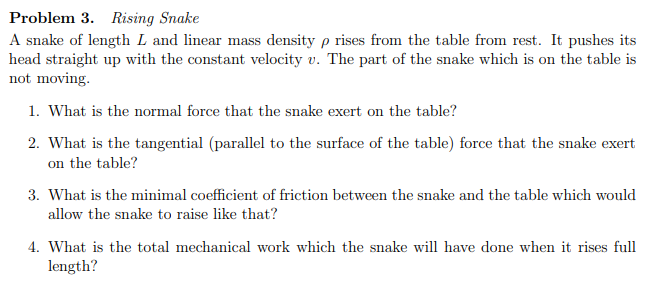Problem 3. Rising Snake A snake of length L and linear mass density p rises from the table from rest. It pushes its head straight up with the constant velocity v. The part of the snake which is on the table is not moving. 1. What is the normal force that the snake exert on the table? 2. What is the tangential (parallel to the surface of the table) force that the snake exert on the table? 3. What is the minimal coefficient of friction between the snake and the table which would allow the snake to raise like that? 4. What is the total mechanical work which the snake will have done when it rises full length?
Problem 3. Rising Snake A snake of length L and linear mass density p rises from the table from rest. It pushes its head straight up with the constant velocity v. The part of the snake which is on the table is not moving. 1. What is the normal force that the snake exert on the table? 2. What is the tangential (parallel to the surface of the table) force that the snake exert on the table? 3. What is the minimal coefficient of friction between the snake and the table which would allow the snake to raise like that? 4. What is the total mechanical work which the snake will have done when it rises full length?
Related questions
Question

Transcribed Image Text:Problem 3. Rising Snake
A snake of length L and linear mass density p rises from the table from rest. It pushes its
head straight up with the constant velocity v. The part of the snake which is on the table is
not moving.
1. What is the normal force that the snake exert on the table?
2. What is the tangential (parallel to the surface of the table) force that the snake exert
on the table?
3. What is the minimal coefficient of friction between the snake and the table which would
allow the snake to raise like that?
4. What is the total mechanical work which the snake will have done when it rises full
length?
Expert Solution
This question has been solved!
Explore an expertly crafted, step-by-step solution for a thorough understanding of key concepts.
This is a popular solution!
Trending now
This is a popular solution!
Step by step
Solved in 4 steps with 4 images
